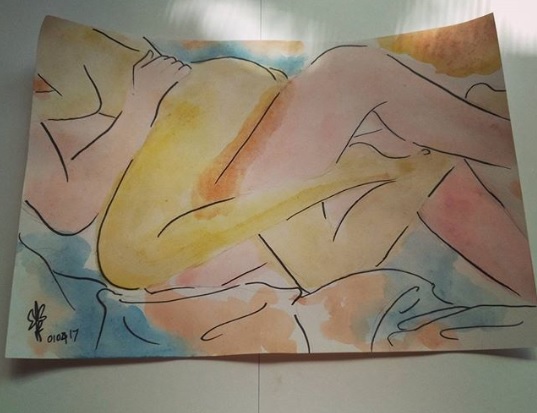Versi Bh. Indonesia
Patresia Kirnandita
In 2015, I started using Instagram to post images of my erotic drawings. I used hashtags such as #eroticart and #eroticdrawing (see Figure 1) but, sadly, many of my posts were deleted or I was not able to make them public. Digital expression is restricted in many countries, and this restriction is particularly acute in the area of sexual expression in the digital realm. The restrictions on my art made me wonder about the experiences of other Indonesians using Instagram to post erotic images. As a result, I began to search for similar posts.
In 2016, I came across an erotic drawing on Instagram that captivated me. It was posted by an Indonesian woman named Candrika. In the caption, she mentioned her experience of visiting a copy centre to scan her erotic drawings. Instead of receiving service like other customers, she was faced with rejection. The employee at the copy centre said, ‘How could a woman draw such obscene things? Sorry, you can’t scan these images here’.
Candrika’s case inspired me to explore #eroticart further and examine the sexual expression of Indonesian women illustrators on Instagram. I found erotic art posted by women who called themselves Farah, Tamy, Ayu, Yuli and Lulu. I wrote to each of them and asked if they would discuss their art with me via direct message. They all agreed and I found that they had interesting stories about their experiences of creating and disseminating erotic artwork.
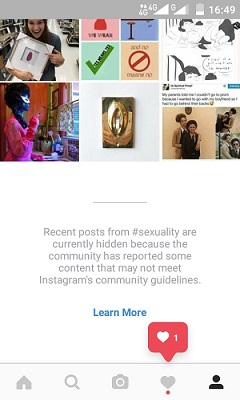
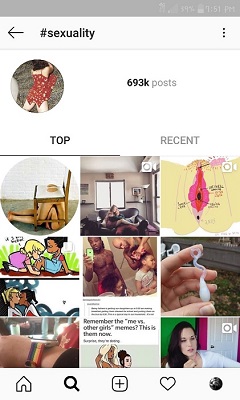
Farah uses the online moniker @laviaminora. She specifically chose this moniker because it sounds like ‘labia minora’ and reflects her intention to promote women’s sexuality. A similar political agenda is observable in Candrika’s engagement on Instagram. When I asked Candrika about her reasons for posting erotic art she said that, ‘Talking about women’s sexuality in public helps other women who might have known nothing about their sexuality or sexual rights. It also teaches men not to treat their partners merely as objects’. Candrika and Farah both post erotic art on Instagram to start conversations in Indonesia about the sexual and reproductive rights of women. This avenue is particularly important as Indonesia’s current moral panic is limiting the spaces in which women can talk about sexuality.
Obstacles
While Farah and Candrika have been able to post their images on Instagram, they and other illustrators have also faced barriers in expressing their erotic art online. Instagram itself can be problematic because it has a policy of removing posts which are reported to them and are deemed to violate ‘Community Guidelines’. One of Candrika’s erotic posts was reported by an Instagram user and it was subsequently removed (see Figure 2).
There are a number of ways in which a post can be deemed to violate the Commuity Guidelines. If any post shows full or partial nudity, or sexual intercourse, it is classed as a violation. These guidelines are in force on Instagram globally. Instagram also bans several hashtags, such as #porn, #sexart, #sexual, #masturbate and #orgasm. However, Instagram does allow users to use other hashtags, which are often quite similar, including #sexualart, #sexualexpression, #pornart, #eroticart, and #femaleorgasm.
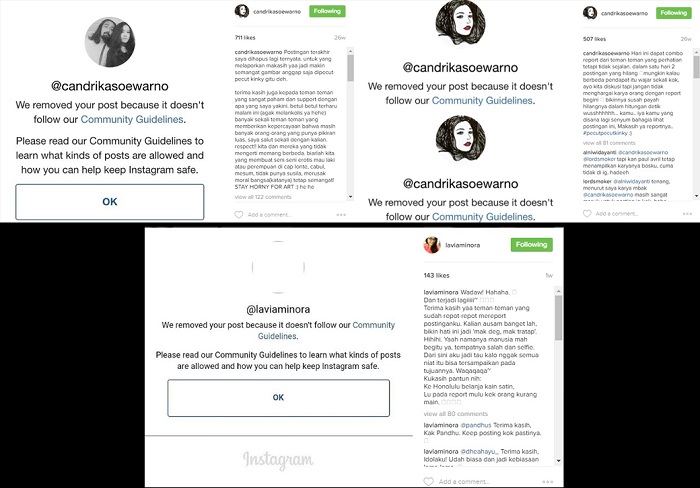
Alongside these general hashtags, there are also restrictions on using Indonesian words such as #memek (vagina), #ngewe (intercourse) and #bokep (porn). However, modified hashtags like #memekbasah (wet vagina), #ngeweperawan (fucking virgin), and #bokepindonesian (Indonesian porn) are allowed. It is possible that these hashtags will also soon be prohibited, particularly as Indonesia becomes more conservative. At present, there is some flexiblity in how illustrators tag their work, and if a post is deleted by Intagram, they can later repost it using a different sexual or erotic hashtag. An example of this reposting is seen in Figure 1a/1b, where, in 2016, the hashtag #sexuality meant posts would be removed but this restriction appeared to have been lifted in 2019.
As mentioned above, Indonesia is experiencing an upsurge in conservative sexual politics. It has never been wise to discuss non-marital sexuality in public in Indonesia, but it is now dangerous to do so. For a woman, in particular, if she expresses her sexuality outside of heterosexual marriage, she might be labeled promiscuous or slutty. If a woman does discuss such issues as sexuality, she is likely to be the subject of harrassment. Farah has experienced this kind of harrassment. After Farah posted some of her erotic art on Instagram, she was condemned by many commentors and called immoral. She also was sent ‘dick pics’ (pictures of penises) by strangers via direct message. In addition, other people wrote to her and made sexual advances.
A further obstacle in terms of posting erotic art on Instagram in Indonesia is that Indonesia now has several laws which restrict sexual expression. According to the Anti-Pornography Law (Article 4) and the Electronic Information and Transaction Law (Article 27), illustrators can be prosecuted if they post erotic art on public forums. Many people in Indonesia consider erotic artwork to be pornographic, which means that erotic artwork is effectively illegal.
The illustrators I talked to argued against conflating erotic art and pornography. Candrika stated, ‘[erotic art] shows more respect to the human body, especially to women’s bodies, while pornography often degrades them and is more exploitative’.
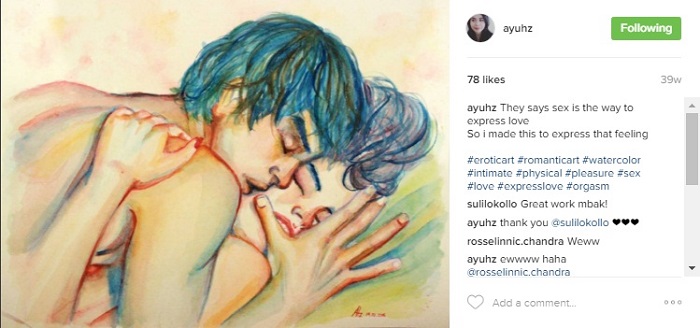
Other Indonesian illustrators also consider erotic art to be very different to pornography. They considered it: an artistic expression reflecting love; a way to show gratitude or feelings towards one’s partner; and a sacred activity rather than merely portraying carnal desire. See for instance, one of Ayu’s images in Figure 3 where her motivation was love. Ayu believes that eroticism does not always have to be linked to sexuality or explicitly portray sexual intercourse. Images featuring all sorts of gestures and poses can be seen as erotic art.
Ayu and the other illustrators I talked to are well aware of the restrictive enviroment they face in Indonesia. They are also aware of the consequences that could befall them if they post erotic art. As such, these illustrators employ strategies to enable the posting of their erotic artwork and to ensure that they avoid unwanted consequences, be that legal ramifications or online harrassment. One strategy that Ayu and the others use is a form of self-censorship. Ayu sometimes blurs part of her images, uses objects to obscure vaginas, or makes the image quite ambiguous. Some of the illustrators, such as Tamy, Yuli and Lulu, also use metaphors to symbolise the vagina, such as images of a piece of fruit or a flower. To emphasise the aesthetic nature of their artwork, the illustrators also often write or post poetry or flash fiction to accompany the images.
Erotic art and ‘artivism’
The women I talked to create and post images of erotic art not just for emotional and aesthetic appeal; these women are also driven by a political desire to empower women – their own sexual expression being one of various avenues for this. The word the women used to describe their efforts was ‘artivism’, a portmanteau of art and activism. Candrika, in particular, positions herself as an ‘artivist’. In one particular erotic art post, which shows four women stimulating their genitals, Candrika wrote about the issue of female masturbation in Indonesia, an incredibly taboo topic. In addition to raising awareness around female masturbation, Candrika wrote about body positivity and consensual sex. In one of her posts, Farah lamented the lack of sex education in Indonesia.
Artivism on Instagram is one way to advocate for women’s rights to a fulfiling sex life and sexual health. The women I talked to have been able to get their message across to a large audience because of the popularity of Instagram and the appeal of hashtags like #eroticart. These women have also made use of their illustration skills and the stories they weave around them to express their messages about women’s sexual rights in a way that is accessible to social media users. Further, the women have linked their artivism across other social media platforms which has assisted in promoting sex-positivity, not only in Indonesia but also globally.
Instagram, if used strategically, can be a space where sexual expression and sex education can overcome the restrictions of social taboos and conservative ruling elites. The opportunity to advocate for women’s sexuality can thus be observed within Indonesia’s digital realm, but it comes with challenges, not least of which is negotating Indonesia’s growing punitive sexual surveillance.
Patresia Kirnandita (pputri1989@gmail.com, Instagram @kirnantresia) is an independent writer and researcher based in Indonesia.
